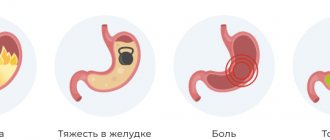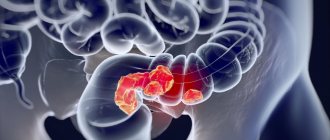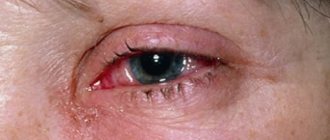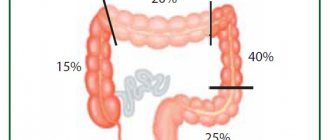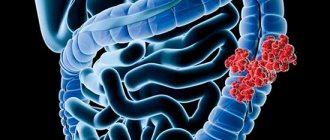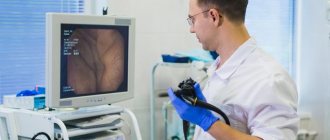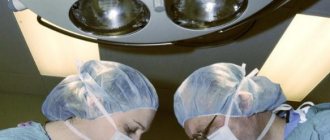- home
- Coloproctology
- Sigmoid colon cancer
Sigmoid colon cancer
Sigmoid colon cancer is an oncological disease of part of the colon, in which a malignant tumor is formed from the epithelium of the mucous membrane. The sigmoid colon, located above the rectum, according to statistics, is one of the organs most often affected by cancer. Most of the oncologist's patients are people aged 45-65 years, with more cases among men.
Depending on the direction of growth, an exophytic form of cancer is distinguished - a formation on a thick stalk grows into the intestinal lumen, and endophytic cancer, when the process spreads along the intestinal wall. In this case, ulcerations appear, the lumen of the intestinal tube narrows, the movement of intestinal contents is difficult.
Tumors of this location also differ in histological structure. Adenocarcinoma is more common - its poorly differentiated variety has an unfavorable prognosis and is characterized by early metastasis. Signet ring cell carcinoma, which is less common, also has a poor prognosis.
Among the negative factors that can lead to illness:
- diverticula, benign polyps susceptible to malignancy;
- diseases of the colon: colitis, Crohn's disease, atony, etc.
- digestive disorders: constipation, problems with peristalsis;
- alcohol abuse, smoking, unbalanced diet;
- some diseases: obesity, diabetes, etc.;
- hereditary predisposition.
Causes
Most of the reasons for the development of sigmoiditis, as an independent disease, lie in the anatomical and physiological characteristics of the sigmoid colon.
Firstly, the main function of the sigmoid colon is the final formation of feces, which can irritate the intestinal mucosa, contributing to the development of microdamages, and therefore creating the preconditions for inflammation.
Secondly, unlike other parts of the large intestine, the sigmoid colon has a curved shape, which delays the passage of intestinal contents through it. This structural feature increases the duration of irritation of the mucous membrane by feces, which increases the likelihood of inflammation.
In addition, reasons also include:
- intestinal infections, such as dysentery and amoebiasis. The bacteria that cause these infections produce toxins that destroy intestinal cells, forming erosions or ulcers. Due to the characteristics of the sigmoid colon, with such damage it is most vulnerable to the inflammatory process.
- intestinal dysbiosis. Among other things, the microflora in the intestinal lumen performs a protective function. With dysbacteriosis, the natural microbial environment is disrupted, which creates conditions for the proliferation of aggressive bacteria, and, consequently, for the development of inflammation.
- nonspecific intestinal ulcers, for example, Crohn's disease or ulcerative colitis. These diseases arise due to allergic factors, and can cause ulceration similar to that of intestinal infections.
- intestinal circulatory disorders (intestinal ischemia). The most common cause of such damage is atherosclerosis. With atherosclerosis, plaques form in the lumen of blood vessels, reducing the amount of blood passing through, thereby interfering with the nutrition of organs and tissues. In the intestine, under the influence of ischemia, areas of necrosis (necrosis) appear, which become the primary foci of inflammation.
- exposure to ionizing radiation – radiation sickness. Under the influence of radiation, some cell structures are destroyed, and free radicals appear - toxic compounds that can damage healthy cells of the body.
Left-sided intestinal inflammation
With left-sided inflammation, the left side is affected. Diagnosed in most cases. This type of colitis is diagnosed when the descending colon, rectum and sigmoid colon become inflamed. The patient is concerned about constipation, increased intra-abdominal pressure, irritation of the mucous membrane and the appearance of anal fissures.
, mucus and blood impurities are found in the stool . The patient feels a frequent urge to defecate, but mucus with small amounts of feces comes out of the body.
Kinds
Like most inflammatory diseases, sigmoiditis can be acute or chronic. In addition, there are the following types, differing in the nature of intestinal damage:
- Catarrhal sigmoiditis. The mildest form, in which only the upper layer of the intestinal epithelium is damaged.
- Erosive sigmoiditis. It is a continuation of untreated catarrhal disease and is characterized by the destruction of the intestinal epithelium with the formation of erosions on it - open, unprotected areas of the mucous membrane.
- Ulcerative sigmoiditis. This form appears with prolonged irritation of erosions on the surface of the intestine, as a result of which they turn into ulcers - deeper defects of the mucous membrane.
- Perisigmoiditis. It is the most severe form of the disease. Through the ulcerative surface, inflammation penetrates into the deep parts of the intestinal wall, reduces its mobility, and the adhesive process begins in the abdominal cavity (the process of connecting intestinal loops to each other).
Symptoms of sigmoiditis
Due to the variety of forms and causes of sigmoiditis, symptoms can vary greatly, but there are three main manifestations characteristic of any type of disease:
Pain in the left iliac region (lower left corner of the abdomen). The pain is intense and can often radiate to the leg or lower back. It should be remembered that the sigmoid colon initially has high mobility, which may result in a change in the localization of pain closer to the central line of the abdomen, or higher, towards the diaphragm.
Changes in the frequency and nature of stool. Diarrhea occurs most often, constipation occurs somewhat less frequently. Sigmoiditis is characterized by an increase in the frequency of the urge to defecate, which is explained by intestinal irritation. Feces are most often liquid, have a sharp, unpleasant odor, and you can see blood, mucus or pus in them.
Deterioration of the patient's general condition. Since during a long course of the disease the human body is depleted, loss of body weight, decreased performance and general well-being, and various sleep disorders are possible.
Chronic intestinal colitis, symptoms
Acute colitis of the sigmoid colon and rectum passes into the chronic stage if the disease is not cured in time. Symptoms appear from time to time, and in the chronic stage they bother the patient every day.
The following signs of the chronic stage of proctological disease are distinguished:
| 1. problems with bowel movements; | In chronic intestinal colitis, both diarrhea and constipation are common symptoms. Constipation occurs much more often, and is accompanied by colic in the stomach, bloating, and flatulence. Increased secretion of intestinal gases occurs after eating. |
| 2. disturbed structure of feces; | Feces have a strange greenish tint and a sour smell. The stool contains mucus, streaks of blood, and pus. |
| 3. nausea and vomiting; | If toxins enter the bloodstream during intestinal inflammation, nausea and vomiting occur. There is an unpleasant odor coming from the mouth. |
| 4. skin rashes; | In some cases, with colitis, intoxication occurs in the body. As a result, rashes appear on the skin, which requires the attention of a dermatologist and proctologist. |
| 5. weight loss; | Due to digestive problems, the patient loses his appetite. He is rapidly losing weight, which leads to hypovitaminosis and decreased immunity. |
| 6. impaired metabolism; | With colitis, metabolism is disrupted, anemia or anemia is observed. |
| 7. problems with blood vessels; | Colitis is accompanied by dizziness, low and high blood pressure. General weakness and drowsiness appear. |
Symptoms of intestinal colitis in men appear with excessive physical activity, drinking alcoholic beverages, and smoking. Painful sensations appear in the stomach and chest. Often these symptoms are confused with heart problems.
Diagnostics
Diagnosis and treatment of sigmoiditis can be carried out by a general practitioner, gastroenterologist, infectious disease specialist, or surgeon.
The main task in making a diagnosis is to carry out differential diagnosis with other inflammatory diseases of the intestines and abdominal organs, such as paraproctitis, ulcerative colitis, as well as with infectious diseases, such as dysentery, cholera, and intestinal dysbiosis.
The results of the following studies are used for diagnosis:
- Interview and examination of the patient, palpation of the abdominal organs. By conducting these studies, the doctor will be able to establish the exact localization of the lesion and draw a conclusion about which part of the intestine is involved in the inflammatory process.
- General blood and stool analysis. These studies will help to accurately determine the severity and nature of the inflammatory process.
- Sigmoidoscopy is performed to directly examine the mucous membrane of the large intestine. Based on the results of the study, it is possible to draw a conclusion about the form of the disease and the area of the lesion, as well as to exclude oncological diseases.
- X-rays are performed to differentiate sigmoiditis from intestinal obstructions.
- For women, data from a gynecological examination to exclude gynecological pathologies such as endometriosis, adnexitis, tubal pregnancy and some others that can give a similar clinical picture.
After collecting all the information, the doctor makes a final diagnosis and prescribes treatment.
General characteristics of the disease
Proctitis is a disease of the sigmoid colon.
To draw correct conclusions about the condition of the sigmoid colon, it is necessary to conduct an examination of the processes that occur inside it. It is necessary to study the physiological and anatomical components of the sigmoid colon.
As everyone knows, the intestine has a thick section and a thin section. Each of them is responsible for performing a specific function.
The thin section is responsible for digesting food and absorbing nutrients, while the thick section supplies the blood with water, glucose, vitamins and amino acids. Fecal matter also forms in the large intestine.
To study sigmoiditis, we need the large intestine. This is where the rectum and colon are located. The terminal portion of the colon is shaped like the letter S, hence the name sigmoid.
Taking as a basis the physiological, anatomical characteristics and the presence of the nearby rectum, we can conclude that sigmoiditis in isolation is quite rare. If it occurs, it is most often in the final section of the gastrointestinal tract.
Treatment of sigmoiditis
Treatment is prescribed depending on the cause of sigmoiditis.
1. For the treatment of sigmoiditis caused by intestinal infections, antibacterial therapy (Biseptol, Tetracycline, Ampicillin, Cefran) is prescribed, covered with bacterial drugs to protect against dysbacteriosis (Lactobacterin, Bifidobac and others).
Also, in chronic cases, intestinal antiseptics such as Intetrix or Smecta are prescribed.
2. To treat sigmoiditis caused by nonspecific inflammatory bowel diseases, use anti-inflammatory drugs that eliminate the underlying disease: Salazoperidazine, Prednisolone, Sulfasalazine.
To combat general intoxication processes, infusion therapy with solutions of glucose, blood plasma and iron supplements (for the treatment of anemia) is used. Also, bacterial preparations are prescribed to normalize the intestinal microflora.
3. For the treatment of ischemic sigmoiditis, the same regimens are used as for the treatment of sigmoiditis caused by nonspecific diseases. In some cases, if such therapy fails, surgery to plasticize the vessels feeding the intestines may be indicated.
In addition, as with any diseases of the gastrointestinal tract, a special diet No. 4 is prescribed, which involves the exclusion of spicy, fried, smoked foods, alcohol, and the maximum reduction in fat, carbohydrates and salt in the diet, and preliminary grinding of food before consumption.
Treatment of sigmoiditis is long-term; in most cases, recovery requires 1-2 courses of therapy, lasting from 1 to 3 months.
Acute intestinal colitis, symptoms
A disease called intestinal colitis is accompanied by a number of symptoms. The pain is cutting in nature and often intensifies with movement. Acute colitis develops after infection or after intoxication of the body.
The following symptoms of proctological disease are distinguished:
- pain syndrome:
Throughout the day, the patient experiences severe pain in the stomach. Unpleasant sensations intensify with any physical activity and even with coughing or sneezing.
- temperature increase;
An inflammatory process develops in the body during colitis, as a result of which in most cases the patient’s temperature rises to 39°C.
- gastrointestinal disorders;
A common disease is bowel movement disorder. The patient suffers from frequent urge to go to the toilet. Diarrhea is accompanied by an increase in blood pressure, the mucous membrane is irritated. With constipation, anal fissures form in the anus.
The patient feels cramping pain in the intestines and the abdomen is bloated. Feces stagnate in the body and fecal stones form. Feces increase in size and lead to intoxication of the body. Frequent urge to go to the toilet sometimes does not lead to bowel movement, during which the walls of the anus are injured.
- impurities in feces;
Impurities of blood, mucus and even pus are found in the stool. The blood is dark brown in color. This symptom indicates an inflammatory process.
- flatulence and heaviness in the abdomen;
After eating, the patient is bothered by flatulence and bloating. Gas formation brings discomfort and disrupts the usual way of life. My stomach is constantly growling. Regardless of food intake, severe discomfort is felt in the stomach area.
- lack of appetite;
Due to problems associated with digestion, the patient has no appetite throughout the day.
- nausea and vomiting;
Nausea is observed after eating. Sometimes vomiting begins, in which impurities of mucus and blood appear.
- cardiac system disorders;
All body systems are interconnected, so in some cases there is an increase in blood pressure, dizziness, and tachycardia.
Signs of intestinal colitis in women are similar to pathological processes in the urinary and reproductive systems. Patients often confuse colitis with problems of the uterus and appendages. If abdominal pain intensifies during sexual intercourse, or vaginal discharge appears, then we are talking about gynecological problems.
In acute intestinal colitis, the symptoms vary in nature and intensity. In the early stages, pain appears extremely rarely and does not cause discomfort to the patient. In advanced stages, the pain does not stop throughout the day and does not disappear even after taking painkillers.
If any signs appear, you should contact a medical specialist, namely a proctologist. The private proctology clinic “Proctologist 81” employs highly qualified specialists and doctors of the highest category. For each patient they select an individual treatment method. Diagnosis of the body is carried out using modern technologies and the latest equipment.
Prognosis and complications
With proper treatment of sigmoiditis, in most cases it is possible to achieve complete recovery, but it should be understood that the treatment process is long and is accompanied by a lot of dietary restrictions.
If left untreated, inflammation may spread to adjacent sections of the intestine, most often to the rectum (proctitis).
Also, as inflammation progresses, the tightness of the intestine may become compromised, resulting in peritonitis - inflammation of the abdominal cavity, requiring extensive surgical intervention.


